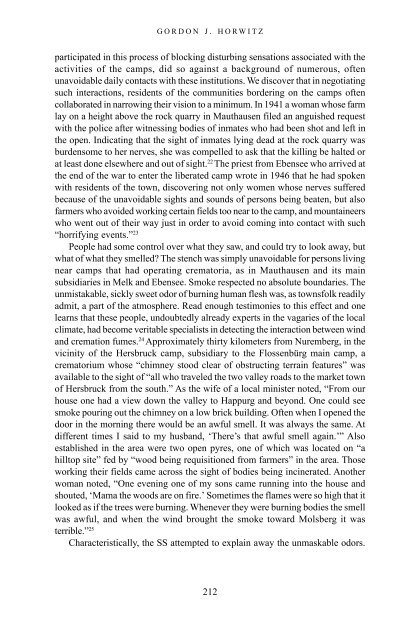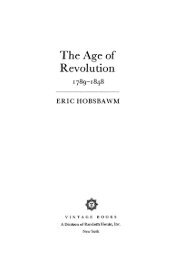The_Holokaust_-_origins,_implementation,_aftermath
The_Holokaust_-_origins,_implementation,_aftermath
The_Holokaust_-_origins,_implementation,_aftermath
Create successful ePaper yourself
Turn your PDF publications into a flip-book with our unique Google optimized e-Paper software.
GORDON J. HORWITZ<br />
participated in this process of blocking disturbing sensations associated with the<br />
activities of the camps, did so against a background of numerous, often<br />
unavoidable daily contacts with these institutions. We discover that in negotiating<br />
such interactions, residents of the communities bordering on the camps often<br />
collaborated in narrowing their vision to a minimum. In 1941 a woman whose farm<br />
lay on a height above the rock quarry in Mauthausen filed an anguished request<br />
with the police after witnessing bodies of inmates who had been shot and left in<br />
the open. Indicating that the sight of inmates lying dead at the rock quarry was<br />
burdensome to her nerves, she was compelled to ask that the killing be halted or<br />
at least done elsewhere and out of sight. 22 <strong>The</strong> priest from Ebensee who arrived at<br />
the end of the war to enter the liberated camp wrote in 1946 that he had spoken<br />
with residents of the town, discovering not only women whose nerves suffered<br />
because of the unavoidable sights and sounds of persons being beaten, but also<br />
farmers who avoided working certain fields too near to the camp, and mountaineers<br />
who went out of their way just in order to avoid coming into contact with such<br />
“horrifying events.” 23<br />
People had some control over what they saw, and could try to look away, but<br />
what of what they smelled <strong>The</strong> stench was simply unavoidable for persons living<br />
near camps that had operating crematoria, as in Mauthausen and its main<br />
subsidiaries in Melk and Ebensee. Smoke respected no absolute boundaries. <strong>The</strong><br />
unmistakable, sickly sweet odor of burning human flesh was, as townsfolk readily<br />
admit, a part of the atmosphere. Read enough testimonies to this effect and one<br />
learns that these people, undoubtedly already experts in the vagaries of the local<br />
climate, had become veritable specialists in detecting the interaction between wind<br />
and cremation fumes. 24 Approximately thirty kilometers from Nuremberg, in the<br />
vicinity of the Hersbruck camp, subsidiary to the Flossenbürg main camp, a<br />
crematorium whose “chimney stood clear of obstructing terrain features” was<br />
available to the sight of “all who traveled the two valley roads to the market town<br />
of Hersbruck from the south.” As the wife of a local minister noted, “From our<br />
house one had a view down the valley to Happurg and beyond. One could see<br />
smoke pouring out the chimney on a low brick building. Often when I opened the<br />
door in the morning there would be an awful smell. It was always the same. At<br />
different times I said to my husband, ‘<strong>The</strong>re’s that awful smell again.’” Also<br />
established in the area were two open pyres, one of which was located on “a<br />
hilltop site” fed by “wood being requisitioned from farmers” in the area. Those<br />
working their fields came across the sight of bodies being incinerated. Another<br />
woman noted, “One evening one of my sons came running into the house and<br />
shouted, ‘Mama the woods are on fire.’ Sometimes the flames were so high that it<br />
looked as if the trees were burning. Whenever they were burning bodies the smell<br />
was awful, and when the wind brought the smoke toward Molsberg it was<br />
terrible.” 25<br />
Characteristically, the SS attempted to explain away the unmaskable odors.<br />
212



